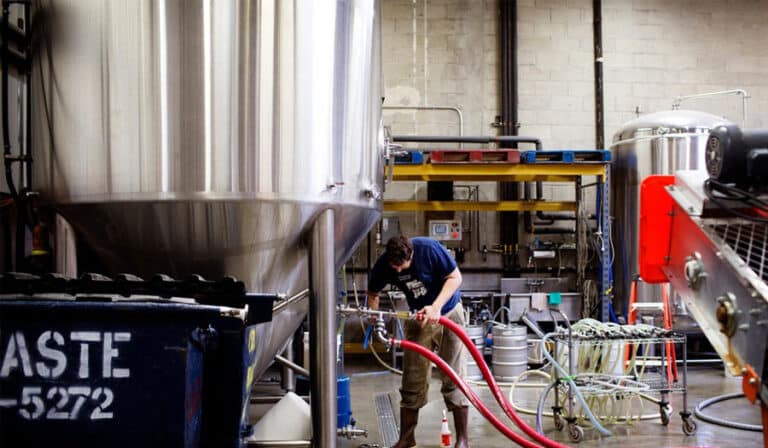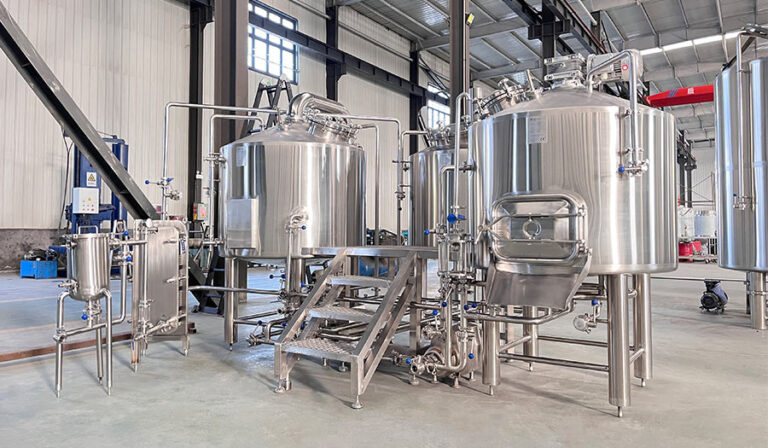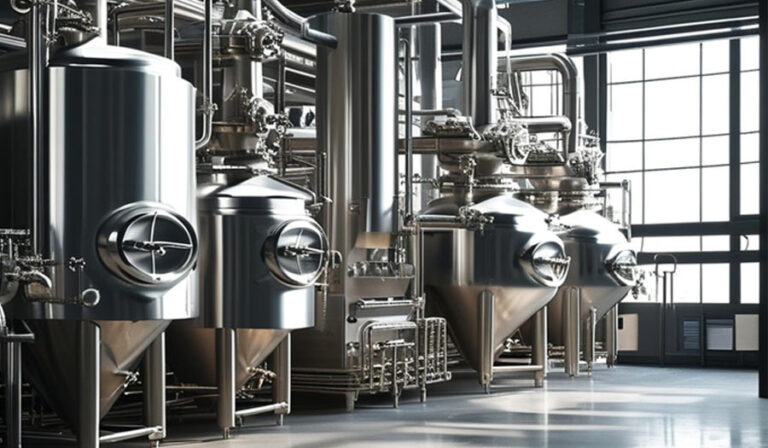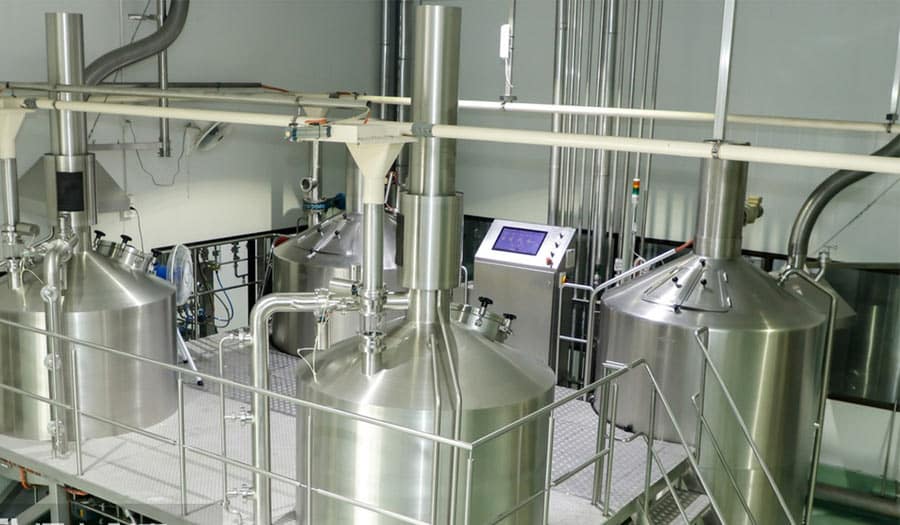クラフトビール文化の台頭により、ますます多くのビール愛好家がビールの醸造に取り組み始めている。 クラフトビール設備 が広く注目されている。これらの機器は中小規模の醸造所に適しているだけでなく、レストラン、バー、クラフトビール店のニーズにも応えています。本ガイドでは、業務用電動クラフトビール機器の種類、機能、メリットなどを詳しく紹介し、ビールメーカーや醸造会社が業務用電動クラフトビール機器への理解を深めることを目的とする。
マッシュ装置
- マッシュポット:麦芽に含まれるデンプンを発酵可能な糖分に変換するために使用される。最新の電気マッシュポットにはデジタル温度制御機能があり、マッシュ温度を正確に制御することができ、マッシュプロセスが安定し、信頼できることを保証する。
- フィルタータンク:麦汁と使用済み穀物を分離し、麦汁の純度を確保する。手作業を減らすため、自動スラグ排出システムを装備することが多い。
- 麦芽粉砕機:麦芽を粉砕し、もろみに適した粒子にする。
- 麦汁ポンプ:糖化した麦汁を次の段階の煮沸装置へ運ぶのに使用する。

沸騰装置
- ボイルポット:麦汁を加熱し、ホップを加えてビールの苦味と香りを抽出する。電気式ボイルポットは均一に加熱できるので焦げ付きにくい。
- ホップ投入装置:ホップの投入時間と量を自動制御し、風味の安定性を確保。
- 蒸気排出システム:沸騰プロセスで発生した蒸気を放出し、安定した機器圧力を維持する。
冷却装置
- 冷却器:煮沸した麦汁を発酵に必要な温度まで急速に冷却する装置。プレート式熱交換器やチューブ式冷却器などが一般的。
- 冷水ポンプ:クーラーに冷却水を供給し、迅速かつ効率的な冷却プロセスを保証します。
発酵設備
- 発酵タンク:麦汁と酵母の発酵工程で使用される中核機器。電気式発酵タンクは精密な温度制御と気圧調整機能を持ち、安定した発酵環境を確保する。
- 圧力計と液面計:発酵タンク内の圧力と液面をリアルタイムで監視し、発酵プロセスの安全性と効率を確保します。
- 自動攪拌システム:一部の発酵タンクには、酵母を均一に分散させ、発酵効率を向上させるための攪拌装置が装備されている。
貯蔵・充填設備
- 完成品の貯蔵タンク:発酵したビールを貯蔵し、熟成させる。
- 充填機:ビールの瓶詰めや樽詰めを行う。最新の設備は通常、自動充填、キャッピング、ラベリングに対応している。
- ガス充填システム:充填時に炭酸ガスや窒素の注入量を調整し、ビールのガスバランスを確保する。
電動クラフトビール機器の利点
正確な温度制御機能
電動クラフトビール機器の中核的な利点の1つは、デジタル温度制御システムであり、マッシュ、沸騰、発酵、およびその他のリンクの温度を正確に調整し、監視することができます。正確な温度制御は、醸造プロセスの安定性を向上させるのに役立ち、ビールの各バッチの品質と風味が一定であることを保証します。この能力は、大規模な商業醸造に欠かせないだけでなく、クラフトビール愛好家の革新的な実験にも有益です。
操作の利便性
従来の機器と比べ、電動クラフトビール機器は操作がよりユーザーフレンドリーです。自動化機能により、面倒な手作業が減り、ユーザーはシステムの指示に従ってパラメーターを設定するだけで、ほとんどの工程が完了する。マッシュでも冷却でも発酵でも、操作はシンプルで直感的だ。このような利便性により、電気機器は中小企業や迅速な生産を必要とする場面に適している。

環境保護と省エネ性能
電気機器は特に省エネと環境保護に優れている。ガス機器と異なり、電気機器は運転中に排ガスを発生せず、環境に優しい。同時に、多くの電気式クラフトビール設備も省エネ設計を採用しており、エネルギー消費量と長期使用コストを効果的に削減することができ、業務用ビール醸造所にとってより経済的な選択肢となります。
効率的な生産能力
電気式クラフトビール醸造設備は、高度な自動化によって生産効率を大幅に向上させた。各リンクの機器が連携して動作することで、醸造工程がよりスムーズになり、もろみから発酵まで連続運転が可能になるため、人の介在による時間の無駄が削減される。この効率性は、大規模生産のニーズに応える必要のある業務用ユーザーにとって非常に魅力的である。
安全性と安定性
伝統的な設備に比べ、電気工芸醸造設備は安全面でより信頼性が高い。多くの設備は漏電防止、過熱防止、圧力制御などの安全機能を備えており、生産におけるリスクを効果的に低減する。同時に、設備は安定的に作動し、外部環境の影響を受けにくいため、醸造工程の安全性とビール品質の安定性がさらに保証される。
適切な業務用電動クラフトビール機器を選ぶには?
機器の素材と品質を考慮する。
機器の材質は、ビールの品質と機器の耐用年数に直接影響する。 業務用電動クラフトビール機器 は通常ステンレス鋼製で、特に304と316の食品用ステンレス鋼は耐食性、耐高温性に優れ、洗浄が簡単で、ビールの安全性と衛生を確保することができます。機器を選択する際には、素材の問題によるビールの品質への影響や機器の破損を避けるため、選択した機器が高品質のステンレスを使用していることを必ず確認してください。
自動化の度合いと操作性を評価する。
自動化の程度は、電動クラフトビール機器の選択に影響する重要な要素の一つである。初心者やクラフトビールの経験のないユーザーにとって、高度に自動化された機器を選択することで、操作の難易度を大幅に下げることができる。最新の電動クラフトビール設備は通常、インテリジェントな制御システムを備えており、簡単なインターフェイス設定で操作できるため、生産効率が向上するだけでなく、人為的な操作ミスも減らすことができます。経験豊富な醸造家であれば、適切な半自動機器や手動操作の機器の方が、個人的なニーズに合っているかもしれない。
予算に応じて機器を合理的に構成する。
機器を選ぶ際、予算は考慮しなければならない重要な要素である。高度に自動化された大容量の設備は通常高価だが、高い生産効率を必要とする大規模な醸造所にとっては投資に値する。予算が限られている小規模醸造所やレストランでは、中小規模の設備一式を選択し、予算を合理的にコントロールすることで、より優れた費用対効果を達成することができる。さらに、設備の経済性を確保するために、設備のメンテナンス費用、運転費用、エネルギー消費などの長期的なコストも予算内で考慮する必要がある。
評判の良い業者を選ぶ。
機器を選ぶ際には、サプライヤーの評判とアフターサービスも重要である。有名ブランドの設備は通常、品質の信頼性が高く、設備の設置、試運転、トレーニング、メンテナンスなどのアフターサービスも充実している。市場での評判が高く、サービス体制が万全なサプライヤーを選ぶことで、設備の品質と長期安定稼働を確保し、設備の故障による生産損失を減らすことができる。
設備の保守・メンテナンスを総合的に考える。
機器のメンテナンスは、長期安定稼働のための重要なポイントです。清掃や修理、部品交換が容易な機器を選ぶことで、操業リスクやダウンタイムを減らすことができる。電気式クラフトビール醸造設備はより複雑であるため、サプライヤーが十分な技術サポートや付属品保証を提供しているかどうかも考慮すべき要素である。長期的な使用においては、定期的なメンテナンスとタイムリーなアップグレードも機器の性能を維持するために必要なステップである。

業務用電気クラフトビール機器の使用とメンテナンス
使用方法
業務用電動クラフトビール機器の使用は、各リンクの操作が規格に適合していることを確認するため、メーカーが提供する取扱説明書に従って厳密に実施する必要があります。まず第一に、操作者は機器の基本的な機能と制御インターフェース、特に機器の起動、停止、調整時に精通している必要があります。電気機器は通常、自動制御システムを備えている。オペレーターは目標パラメーター(温度、時間など)を設定するだけで、装置は自動的に運転される。しかし、生産量の変化に対応するためには、定期的に装置の運転状態を監視し、パラメータを適時調整する必要がある。また、使用前には、装置のすべての接続、特に電源、冷却システム、ガスパイプラインがしっかりしているかどうかをチェックし、過失による故障を避ける必要がある。各生産リンクが完了した後、汚染や機器の損傷を防ぐために、時間内に機器を洗浄し、消毒する必要があります。
機器の洗浄と消毒
定期的な洗浄と消毒は、業務用電動クラフトビール機器のメンテナンスの基本作業です。使用後は、装置内の麦汁残渣、ホップ残渣、酵母などを徹底的に洗浄する必要があります。マッシュポット、ボイルポット、発酵タンク、クーラーなど、機器の各部分は、汚染やスケールを防ぐため、使用頻度に応じて定期的に洗浄する必要があります。多くの業務用機器は、洗浄プロセスを簡素化するために、洗浄インターフェースやCIP(定置洗浄)システムを備えて設計されている。洗浄効果を確実にするため、オペレーターは適切な洗浄剤を使用し、推奨される濃度と洗浄ステップに従う必要がある。同時に、衛生的なビール品質を確保するため、機器内部に残留物がないか定期的にチェックする。
メンテナンス
業務用クラフトビール電気機器の長期安定稼働は、定期的なメンテナンスにかかっている。まず、電気機器の回路や制御システムを定期的にチェックし、電気的な故障や過負荷がないことを確認する必要があります。モーター、ポンプ、サーモスタットなどの主要部品は、長期間の使用による摩耗や故障を避けるため、定期的に点検し、注油する必要があります。装置の水管および空気管システムも定期的に点検し、水漏れ、空気漏れ、閉塞がないことを確認する。装置が冷却システムを使用している場合、スケールや不純物が冷却効果に影響するのを防ぐため、冷却水の交換と洗浄も非常に重要である。シール、フィルター、パイプなどのいくつかの消耗部品は、装置の正常な運転を確保するために定期的に交換する必要があります。メンテナンスの際には、機器メーカーのメンテナンスガイドを参照し、各点検・メンテナンスの内容を記録し、機器の健康状態を把握する。
トラブルシューティング
通常、業務用のクラフトビール用電気機器は比較的頑丈に設計されていますが、長期間の運転ではどうしても小さな故障は避けられません。そのため、オペレーターは問題をいち早く察知し、対策を講じることができるよう、一定のトラブルシューティングの知識を持つ必要がある。よくある問題には、不安定な電力供給、機器の過熱、冷却システムの故障、液面の異常などがある。これらの問題が発生した場合、オペレーターはまず機械を停止させて点検を行い、故障の種類に応じて適切な処置を講じる必要がある。より複雑な故障については、機器メーカーの技術サポートチームまたは専門のメンテナンス担当者に修理を依頼するのが最善である。装置を定期的に自主点検し、常に注意を怠らないことで、突然の故障が生産に与える影響を効果的に回避することができる。
結論
業務用電動クラフトビール機器は、クラフトビール愛好家や中小規模の醸造会社に、効率的で安全、かつ操作が簡単なソリューションを提供します。合理的な機器の選択、標準化された操作、定期的なメンテナンスにより、ユーザーは高品質のビールを製造できるだけでなく、生産効率を大幅に向上させ、運営コストを削減することができます。市場の継続的な需要拡大に伴い、電動クラフトビール設備への投資は潜在的な選択肢となるだろう。




